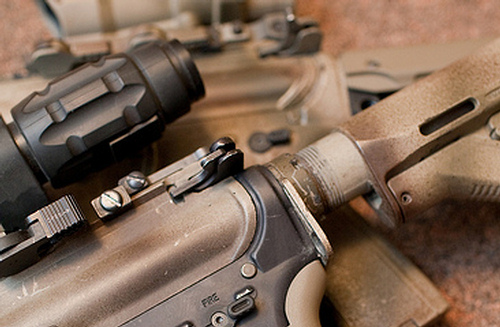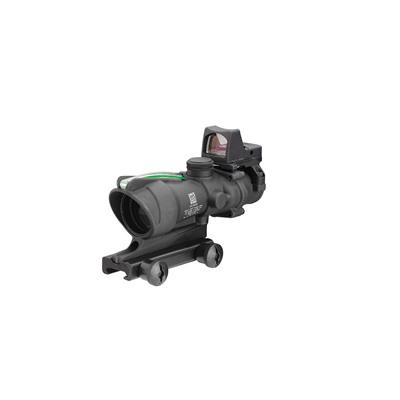What is better in the battle between ACOG vs EoTech with a magnifier? Inquiring minds want to know, so we happily frolicked through the most advanced sights ever fielded on a rifle.
Both an ACOG and an EOTech have a few things in common. Both have been used in combat by the US military, and both can provide low power magnification. However, where an EOTech is battery-operated, an ACOG uses radioactive tritium to provide illumination. Both have advantages and disadvantages that we will cover later, but now let’s take a look at a couple of pairs of such sights.
EOTECH HHS II VS Acog 4 X 32
Price
Here we are going to consider the merits of these optics based on price, usability, and features.
There’s not a huge difference in price considering in each case but it is nothing to sneeze at either. If price is your bottom line, run with the EOTech since it’s usually cheaper (check current prices, though).
Usability
Well, they are both combat-proven optics. The EOTech is a standard EOTech HHS II paired with a 3 power fixed magnifier. In this case, two popular items were paired and packaged together. The magnifier flips out of the way when not in use, allowing rapid transition between a red dot and a magnified red dot. Meanwhile, over on the ACOG side of the table, the 4×32 is a fixed four power magnified scope. Unlike the EOTech, the ACOG is built from the ground up to be magnified and requires no additional accessories. However, for those who might care, it cannot transition between a non-magnified reticle and a magnified one—it’s just a standard 4x magnification.
Battery Life & Electronics
One can also compare the tritium and fiber optic illuminated ACOG with the battery operated EOTech; however, for all practical purposes since even the most elite forces on this planet use both, buy the EOTech if you want to transition between magnified or unmagnified or run with the ACOG if you have no preference.
By virtue of examining usability, we touched on some features, and now we can touch on a few more. ACOG’s have no electronic circuits to fail. They use natural light illuminated fiber optics and radioactive tritium vials to illuminate the reticle, making them extremely robust. EOTech uses batteries for their rugged sights. Both mount on a standard Picatinny rail, both are compatible with night vision devices, and both are built to a high military standard.
If You Must Have a Red Dot and an ACOG . . .
The ACOG comes up short in its ability to transition between a magnified optic and a red dot. However, there is a solution to that as well, although at a price:
Here, we have a standard ACOG unit paired with a high quality red dot sight. An operator can quickly transition between a red dot and a magnified scope even quicker than flipping the magnifier on an EOTech out of the way. This does come with a price though, unless you are married to the idea of an ACOG, an EOTech with a magnifier usually offers cost savings and similar functions.
Is There Much Real Difference in ACOG vs. Eotech with Magnifier?
Well . . . maybe if you are a member of an elite special forces unit or happened to be issued one or the other in the military and want to have an optic you are familiar with on your privately owned rifle. Seriously, though, for most of us, the main difference is cost, which is negligible until you start pairing an ACOG with a red dot. In that case, price-wise, the EOTech is the big winner.
There are only a small handful of different models of each sight and for good reason. These are optical sights we’re talking about, not the internal workings of a rocket that’ll fly you to Nepune. You’re going to get either a high-quality non-magnified holographic sight or a high-end magnified scope.
If You Must Get an EoTech
So there’s little sense in reviewing all the small model variations for an ACOG or EOTech. If you buy an EOTech, you’ll probably want to invest in a magnifier (see our article on the best red dot magnifiers). If you want a magnifier that’s also an authentic EOTech, well, be prepared to spend as much (or even more) on this puppy as you had on your standalone EOTech sight itself. For example, here’s are a standard Eotech stand-alone model and following is the EoTech Magnifier.
ACOG Choices
The choices for an ACOG get even narrower. The optional red-dot sight that we listed above is your biggest and probably only choice. If you want magnification all the time, you’ll be buying an ACOG.
Conclusion of ACOG vs. Eotech with Magnifier
My own personal choice is a magnified EOTech. It is more visually appealing (to me anyway) and it’s typically a bit cheaper than an ACOG. I don’t really, in the end, care enough about the differences between the two. Both are widely used in more intense situations than most people will ever find themselves in.
Wile the tritium used in an ACOG is safe to handle, it does have a practical life of about 15 years before it has to be replaced. An EOTech just needs batteries and can run up to 600 hours on a single battery.
There are pros and cons to each, but in 15 years, I suspect I’ll have an easier time buying a battery than a tritium vial. Either way, both are amazing optics, and the American public is fortunate to be able to choose between them, and you’ll be happy no matter whichever choice you make.











Loved the info. I recently bought a dog m400 it came with a scope and want to change it
Acog scopes are better by far. They will work no matter what without a battery and Trijicon will replace the tritium for free every 12-15 years on warranty.
Eotech sights have huge problems that cannot be solved. Red dot drift from extreme temperatures can cause huge differences on point of impact. They are not as durable and have parallax.
The Acog does not have these problems. Because the crosshairs/dot is etched into one of the lenses, there is no Red dot drift. There is no Paralax. They have hatch marks for 556 ammo at 100-800 meters. They require no batteries and are almost indestructible. Also a magnified Acog can be used as a quick acquisition red dot while keeping both eyes open, the image of the reticule is superimposed over the non aiming eye.
The only downside to an Acog is your eye has to be pretty close to the scope. It is overstated tho. It has a comfortable eye relief I’ve never had problems with.
There is no better friend I’d want to tag along with my rifle than an Acog. I’d recommend one over any other optic. They are expensive but flawless and precision instruments that are built to outlast your rifle. They are usually more expensive or the same price as a new mid range AR15 . But they are totally worth it and I’d never go without one. Ever.
Chris, Yeah but how do you fee about ACOG’s? Lol
Really enjoyed reading about the differences. I have not been shooting long and my husband had a hard time with my questions on this subject.
I’m ex-INFANTRY and SF …
I own both and have been using EOTech with the old 4x flip to side magnifier for many many many years and then switched over to acog’s about 10 years ago but still use both.
I would bring the ACOG into battle as a first choice because of its recognition use of tritium instead of a battery, but the EOTech has a very distinct advantage on rapid target engagement that the ACOG has never been able to match.
With that bright 65 mil circle in the middle ability to line up over a torso, and that massive screen that is almost like a TV set, you get instant target identification and engagement, whereas with your ACOG, you’ve got to kind of spend a second to line things up and search your eye relief to get started.